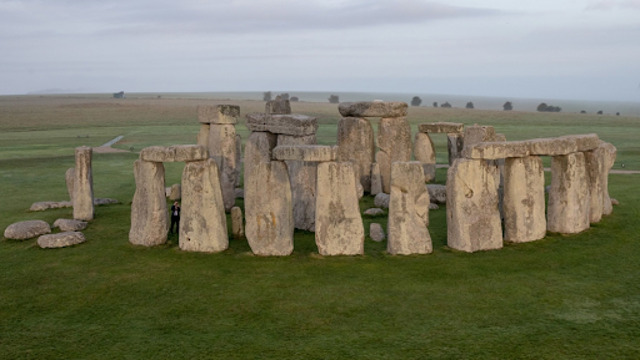
On September 7, 2016, Stonehenge, the ancient monument, was captured from a hot air balloon flying over Wiltshire, England. The iconic stone circle stood proudly as the stunning aerial view revealed its grandeur from above. CNN
In a year of groundbreaking discoveries, scientists have uncovered new insights about Stonehenge, one of the world’s most famous and enigmatic ancient monuments. Researchers have revealed that the Altar Stone, a massive monolith in the center of the stone circle, was transported from northeastern Scotland to southern England around 5,000 years ago. This revelation follows a series of studies this year that have gradually peeled back the mystery surrounding Stonehenge’s construction and purpose.
The Altar Stone is one of the most iconic elements of Stonehenge, and its origin has been a subject of much speculation. In August, a team of researchers confirmed that the stone, weighing 13,227 pounds (6 metric tons), had been moved over 435 miles from Scotland. Initially, experts considered the stone’s possible connection to Orkney, an archipelago off Scotland's northeast coast, home to other Neolithic sites. However, a later study in September ruled out Orkney as the origin, and the search for its true origin continues.
New research sheds light on a critical phase in the history of Stonehenge, suggesting that around 2620 to 2480 BC, the monument was rebuilt as part of an effort to unite ancient Britons. This reconstruction likely coincided with the arrival of new settlers from Europe. The research, published in a recent journal, also explores how Neolithic people might have moved the giant stones. The large Altar Stone, along with other massive rocks, would have been dragged by sledges across the land, a process that could have taken several months, involving hundreds, possibly thousands, of people.
Stonehenge, constructed over several centuries starting as early as 3000 BC, has always fascinated scholars. The monument consists of two main types of stone: the smaller bluestones, which came from the Preseli Hills in Wales, and the larger sarsen stones, which were sourced from the West Woods of Marlborough. However, the Altar Stone stands out due to its size and placement within the circle. It lies near the center of the monument, and its placement holds special significance, especially during the solstices.
Mike Parker Pearson, the lead researcher, explained that the large stone monoliths at Stonehenge are likely tied to ancestral beliefs. The Altar Stone’s position aligns with the midwinter solstice, and its connection to the cosmos suggests that the monument had both religious and astronomical significance. “There’s good evidence to suggest that these large stone monoliths have ancestral significance,” Parker Pearson said. “The Altar Stone’s location within Stonehenge is important as if you stand at the center of the stone circle, the midwinter solstice sun sets over its middle.”
The Altar Stone is positioned beneath two larger sarsen stones. CNN
The study also highlights a political element in the reconstruction of Stonehenge. The monument’s massive stones were sourced from distant regions, indicating that the builders may have used the site to unite different groups across Britain. The act of moving these stones could have been a significant gesture of unity, bridging communities from different regions. Researchers believe that the Stonehenge reconstruction, along with the movement of the stones, helped cement a connection between these far-flung groups, creating a shared identity tied to their ancestors and the cosmos.
As part of the effort to understand how the Altar Stone made its way to Stonehenge, researchers have noted similarities between the architectural styles of homes found at Durrington Walls, near Stonehenge, and those in the Orkney Islands. Additionally, pottery styles across Britain point to shared cultural practices between the two regions, suggesting that the builders of Stonehenge and the communities in Scotland had a closer relationship than previously thought.
While the true purpose of Stonehenge remains uncertain, this new research paints a picture of the monument as a symbol of unity and cooperation, designed not only to mark the sun’s movements but also to bring together various peoples and cultures during a time of change.















